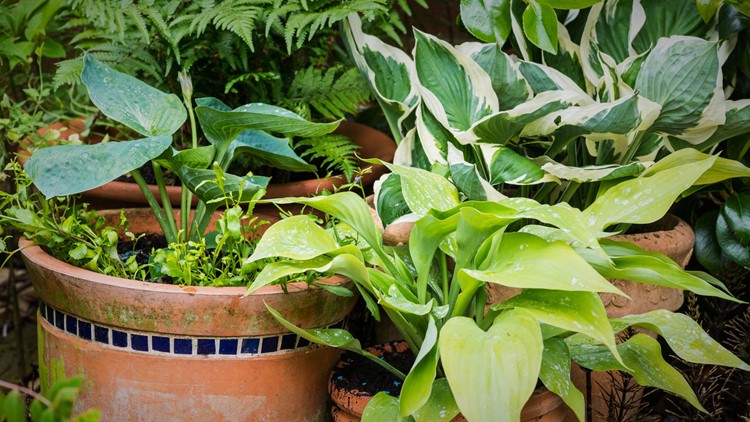Seattle — Hostas come in all different colors, shapes and sizes and make a perfect addition to a shady part of your Pacific Northwest garden. Gardening expert Ciscoe Morris shows New Day Northwest how to care for, protect, and divide them.
Hostas are spectacular plants for a moist shady location. These long lived natives of Japan and China come in a mind boggling array of sizes, shapes and colors; everything from tiny miniatures, such as Yakushima Mizu, a 3 inch tall munchkin sporting tiny dark green leaves and teeny lavender flowers, to the big mamma of them all, Empress Wu, forming a massive mound of wavy, thick, corrugated blue-green leaves that can exceed 48 inches tall and 70 inches wide. Hostas add color and texture in shady nooks in the garden and combine beautifully with plants with fine foliage, but they also look great in containers. The flowers are attractive to hummingbirds Smaller growers add bold texture and lively color in mixed designs; while the bigger leaved ones make elegant specimens in large pots or in back areas of the garden. Hostas perform best planted in moist soil in bright shade. Avoid direct sunshine which will burn the leaves, causing ugly brown spots. Mulching around the plants slows evaporation and reduces the need to water as often. Fertilizing Hostas growing in pots once per month with a soluble house plant fertilizer will keep them looking lustrous and colorful. Hostas growing in the open shade garden generally only need one application of a granular organic flower food, but if you want one to grow big, feed with high nitrogen, organic lawn food every 6 weeks. Anyone who has ever grown Hosta knows that slugs and snails consider the leaves a gastronomic delight. Apply the safer brands of slug bait containing iron phosphate such as Sluggo, Worry Free or Escargot regularly, and make frequent night-time visits to put the ‘el kabotski’ on any gastropod gourmets that find their way past your defenses. Note that Hostas with blue foliage are less attractive to slugs than those with yellow or green leaves.
Hosta rarely needs dividing, but if you want to start a new clump, it is one of the easiest perennials to divide. Wait until spring when the leaves are about 4 inches tall. Then simply use a digging spade to cut out a section and move it to a new location. Voila, you've got a new colony of Hosta.
Some favorites that I showed on today's show is 'T-rex'. The monstrous green leaves of 'T Rex' Hosta are slightly wavy and floppy that forms a gigantic mound of corrugated green foliage that 36 inches tall by 80 inches wide.
Another monster that I love is 'Sum and Substance'. It has yellow foliage and is very fast growing, quickly reaching 2 to 3 ft. tall, 5 to 6 ft. wide.
A new variety that really caught my eye is 'Fire Island'. This one has Brilliant gold rippled leaves on deep red stems that provide a beautiful contrast in the garden! Lavender flowers spikes that attract hummingbirds appear in mid summer as foliage matures to chartreuse. Provides excellent coverage for fading bulb foliage. This small fast grower to 10 - 12 in. tall and 18 - 30 in. wide is a vigorous grower perfect for the front of the shady garden border.
'Great Expectations' features bright textured leaves with a yellow center edged with sea green markings, and are topped with many white flowers in summer. Each leaf is unique and brightens the shade garden with its warm golden tones. Great Expectations is a slow grower but is well worth the wait and is Slug resistant.
A real cutie if you like little Hostas is 'Blue Mouse Ears'. A symmetrical mound of small, heart-shaped foliage with a slight curl that resemble mouse ears. The soft blue-gray leaves have a faint white edge in early spring. The thick foliage resists slug damage. Lavender flowers stand above the foliage clumps.
Also slug resistant, and perhaps my favorite Hosta of all is' June'. On this gorgeous perennial distinctive gold leaves with striking blue-green margins stand out in lightly shaded beds and woodland gardens. Pale lavender flowers appear on showy scapes above the foliage in summer. Heavy, substantial foliage resists slug damage.
A gorgeous middle sized very showy Hosta is' Sagae' with spectacular large blue-green leaves with variations of creamy white on the margins.
I could go on with a hundred more Hostas that I love, but it would take way too much space. By the way, the Japanese have been eating hostas safely for centuries. Known as urui, they're commonly boiled, fried in tempura or eaten raw. With a flavor reminiscent of lettuce and asparagus, they can easily be substituted in salads. Hey, it would be a waste eating something this gorgeous!
Good gardening!
Ciscoe
Watch New Day Northwest 11:00 weekdays on KING-TV Ch.5 or streaming live on KING5.com. Connect with New Day via Facebook, Twitter, Instagram.



